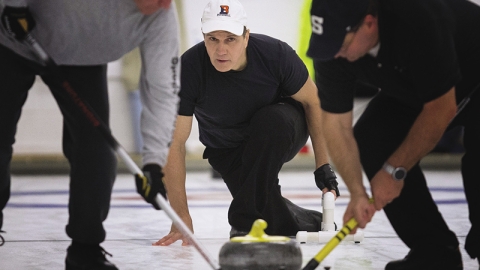
An Icy Bond
January 19, 2016
Bruce Clouser ’80 releases a curling stone as sweepers move it down the ice at the Philadelphia Curling Club.
Generations of Philadelphia-area Bison are swept up in the curious game of curling.
Pamela Stephani '74 was traveling for work in Canada in the late 1990s. Several times in her hotel room at night she turned on the television to see a game, a sort of shuffleboard on ice, called curling.
"It was mesmerizing; it seemed like a kind of chess, with strategy and all," says Stephani. "I knew if I had the chance, I would love to try it."
Living west of Philadelphia, though, it did not seem as if a winter-bound sport like curling would ever come her way. But in spring 2006 she heard about a Bucknell alumni club event at the Philadelphia Curling Club in Paoli, Pa., only a few miles from her job at the Vanguard mutual fund company, from which she retired in 2015.
"I went and I became hooked," says Stephani, who is one of about a dozen Bucknell alumni and parents who curl or have curled at the club.
On a recent Wednesday evening, for instance, Stephani curled on a team against Daniel Dudt '17, his father, Brian, and brother Andrew, a high-school senior.
Daniel Dudt has been curling at Paoli since he was 6. His mother’s parents had some Canadian friends who introduced the family to the game. His maternal grandmother, Barbara Moore Hutchinson '55 and his aunt, Ginger Hutchinson Pohlman '82, are longtime curlers.
"It may be one of the only sports where a grandparent, a parent and a child can all play on the same team at the same time and there would be no second thought about it," says Stephani. There are no formal Bucknell teams at Paoli, but nearly any night or weekend she might encounter someone with a Bucknell connection, she says.
The rudiments of curling are simple. Like shuffleboard, the goal is to have your 38-to-44-pound stones rest in point-scoring areas at the finish of each "end," as rounds are called. Instead of shuffleboard’s triangle of scoring, there are concentric circles. Each team of four throws two stones, for a total of eight, in each end — knocking the opponents’ stones out of the way or throwing them so they block an opponent’s path.
The ice path is usually about 150 feet long. A throw actually means sliding a rounded stone by its handle down the ice, releasing it behind a line after a short lead up, the thrower stooping low with one leg bent in front and the other stretched out in back. Two broom-wielding sweepers follow the stone down the path to the target, brushing the ice — which warms it up and flattens it out — as necessary to direct the stone.
Dudt plays enough on vacations and the occasional weekend to make it to national competitions. He will be on an all-star team of sorts out of North Dakota this year in hopes of making it into international competition, where Canada and the Scandinavian countries are usually the best. Dudt says he would love to make the Olympic team.
"People like to ask me about that, but I am focusing on a career as an engineer," he says, but then pauses. "But I would certainly not be opposed to making it. You can’t make a living as a competitive curler, but I have done it all my life and plan to compete forever."

